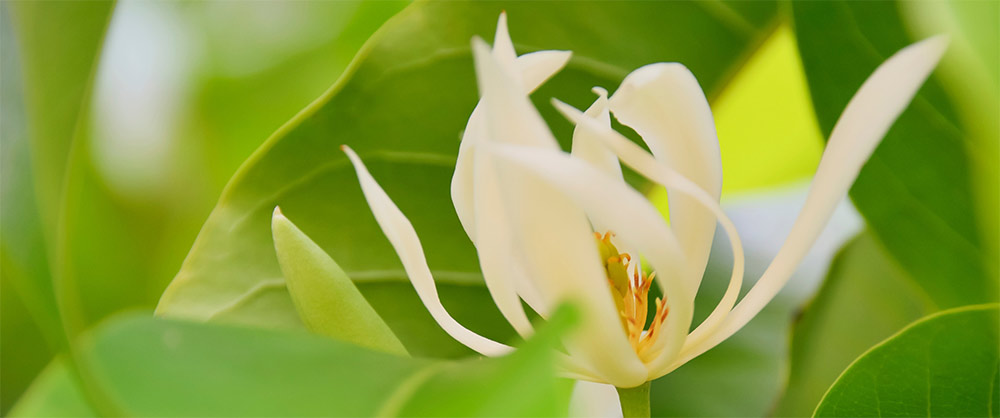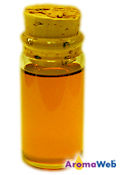Magnolia Essential Oil
Michelia alba

Description
Magnolia Essential Oil is also known as White Champaca Essential Oil.
The aroma of Magnolia Essential Oil is beautifully floral and powerfully fragrant. I find it to be sweetly floral with underlying fruity, woody and balsamic notes.
Aromatically, Magnolia a lovely essential oil to work with. Its usage is most prevalent in perfumery applications. If you enjoy floral essential oils such as Neroli, Rose, Ylang Ylang and/or Tuberose Absolute, there is a good chance that you will appreciate the aroma of Magnolia Essential Oil.
Over the past few years, I am seeing it more readily available from reputable essential oil sellers. The countries of origin that I'm typically seeing for Magnolia Essential Oil is China and Thailand. I have much more to learn about the Michelia alba species of Magnolia Tree, but it sounds like the tree does not thrive in the wild and is primarily cultivated in regions of Asia.
Not much has been written about Magnolia Essential Oil from an aromatherapeutic perspective. I see Magnolia Flower Oil well worth considering for its aromatherapy benefits for emotional and mental health applications and also to a lesser degree, for its benefits for skin care and other physical applications.
Due to its cost and rarity, Magnolia Essential Oil is more likely to be adulterated. It's important to be sure to purchase only from reputable sources. Robert Tisserand reports that Magnolia Essential Oil may be co-distilled with ylang-ylang blossoms. [Source: L.P. Oyen and N.X. Dung (Editors) Plant Resources of South-East Asia, Backhuys, Leiden, as cited in Essential Oil Safety Edition 2.]

Magnolia Essential Oil Benefits and Uses
- Scars
- Muscular Aches
- Abdominal Cramps
- Fear-Induced Anxiety
- Insomnia
- Improving Communication
- Depression
Source: Valerie Ann Worwood, The Complete Book of Essential Oils and Aromatherapy, 25th Anniversary Edition (Novato, CA: New World Library, 2016), 601.
Botanical Name
Plant Family
Common Method of Extraction
Steam Distilled.
Magnolia Absolute is also available. However, this profile pertains specifically to the steam distilled essential oil. (Learn More About Absolutes)
Plant Part Typically Used
Color
Orange / Amber
Consistency
Thin
Perfumery Note
Middle
Strength of Initial Aroma
Medium
Aromatic Description
Magnolia Essential Oil smells sweetly floral with underlying fruity, woody and balsamic notes.
Source: Tony Burfield, Natural Aromatic Materials: Odours & Origins, Second Edition (Tampa, FL: The Atlantic Institute of Aromatherapy, 2016), 534-535.
Sustainability and Conservation Status
Not Evaluated by the IUCN Red List of Threatened Species
Source: IUCN Red List Search for Michelia alba
To learn more about the conservation status of essential oil bearing plants and how to use the IUCN Red List of Threatened Species, please refer to AromaWeb's Guide to Essential Oils and Sustainability.
Major Constituents
- Linalol (Linalool)
- B-Elemene
- B-Caryophyllene
- (E)-B-Ocimene
- (Z)-B--Ocimene
- Methyl 2-methylbutyrate
- Methyleugenol
Source: ISO17382:2007
Magnolia Essential Oil Safety Information
Magnolia Essential Oil contains methyleugenol and thus must be used very mindfully because methyleugenol is a known carcinogen. Tisserand states that he "recommends a dermal maximum of 0.9% based on 2.3% methyleugenol with a dermal limit of 0.02%."
The Magnolia Flower Essential Oil profile on pages 341-342 of Essential Oil Safety Edition 2 states that there are no known hazards or contraindications. However, the key constituents that Robert Tisserand cites in his profile do not include methyleugenol. It must have been left off of the analysis that Robert Tisserand was assessing when preparing his safety profile. As such, it is recommended that you also refer to Robert Tisserand's profile for White Champaca Absolute (solvent extracted from Michelia alba) on pages 245-246 which cite approximately 2.3% methyleugenol composition which seems consistent with the methyleugenol composition that I'm finding in GCs for Magnolia Essential Oil.
Reading Tisserand and Young's complete profile for both the essential oil (pages 341-342) and for the absolute (pages 245-245) is recommended. Source: Robert Tisserand and Rodney Young, Essential Oil Safety (Second Edition. United Kingdom: Churchill Livingstone Elsevier, 2014), 245-246 and 341-342.
Magnolia Essential Oil References
- Valerie Ann Worwood, The Complete Book of Essential Oils and Aromatherapy, 25th Anniversary Edition (Novato, CA: New World Library, 2016), 601.
- Tony Burfield, Natural Aromatic Materials: Odours & Origins, Second Edition (Tampa, FL: The Atlantic Institute of Aromatherapy, 2016), 534-535.
- Robert Tisserand and Rodney Young, Essential Oil Safety (Second Edition. United Kingdom: Churchill Livingstone Elsevier, 2014), 245-246 and 341-342.
- Steffen Arctander, Perfume and Flavor Materials of Natural Origin (Reprint Edition. Elizabeth, NJ: Pathfinder., 2017), 158.
General Safety Information
Do not take any oils internally and do not apply undiluted essential oils, absolutes, CO2s or other concentrated essences onto the skin without advanced essential oil knowledge or consultation from a qualified aromatherapy practitioner. For general dilution information, read AromaWeb's Guide to Diluting Essential Oils. If you are pregnant, epileptic, have liver damage, have cancer, or have any other medical problem, use oils only under the proper guidance of a qualified aromatherapy practitioner. Use extreme caution when using oils with children and be sure to first read the recommended dilution ratios for children. Consult a qualified aromatherapy practitioner before using oils with children, the elderly, if you have medical issues or are taking medications. Before using this or any essential oil, carefully read AromaWeb's Essential Oil Safety Information page. For in-depth information on oil safety issues, read Essential Oil Safety by Robert Tisserand and Rodney Young.
Shelf Life
Important Information About the Profiles
The essential oil information provided on AromaWeb is intended for basic educational purposes only. The references to safety information, test results, constituents and percentages is generalized information. Essential oils can vary greatly in composition. The data is not necessary complete and is not guaranteed to be accurate. The essential oil photos are intended to represent the typical and approximate color of each essential oil. However, essential oil composition and color can vary based on harvesting, distillation, age of the essential oil and other factors. Profiles for several CO2 Extracts and absolutes are included within the directory, and are denoted as such.
